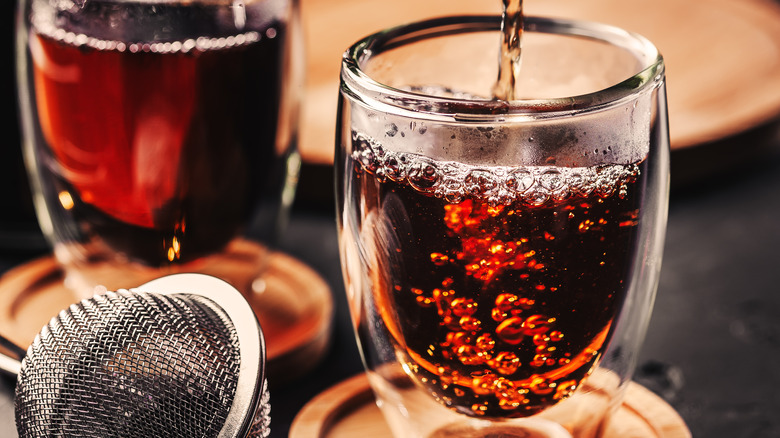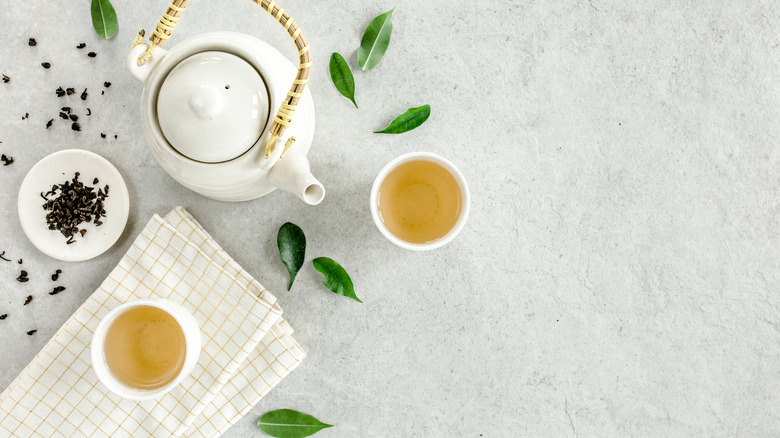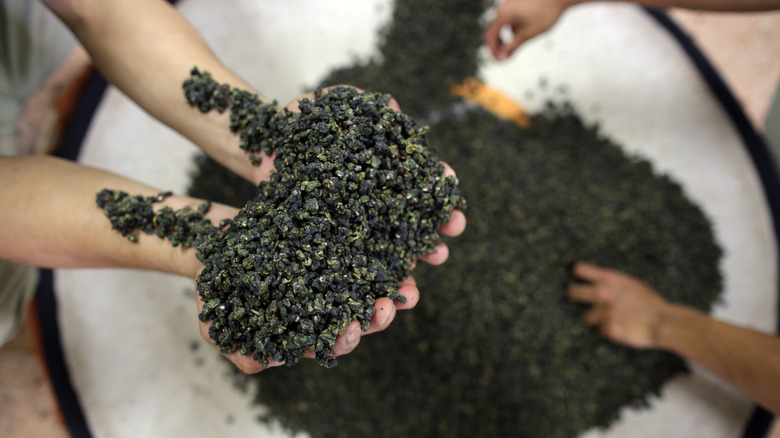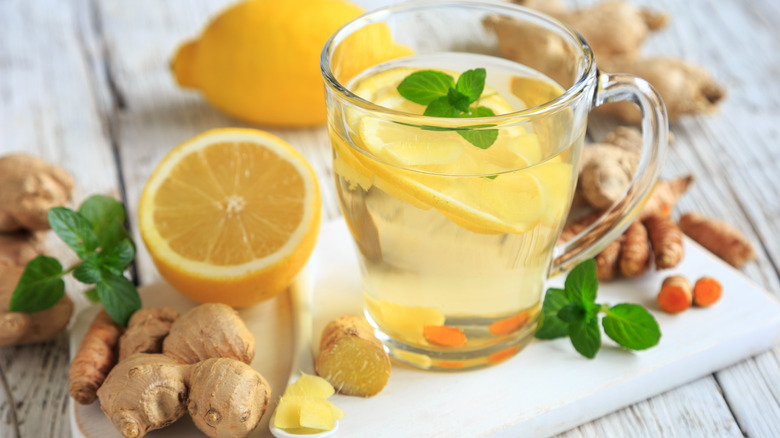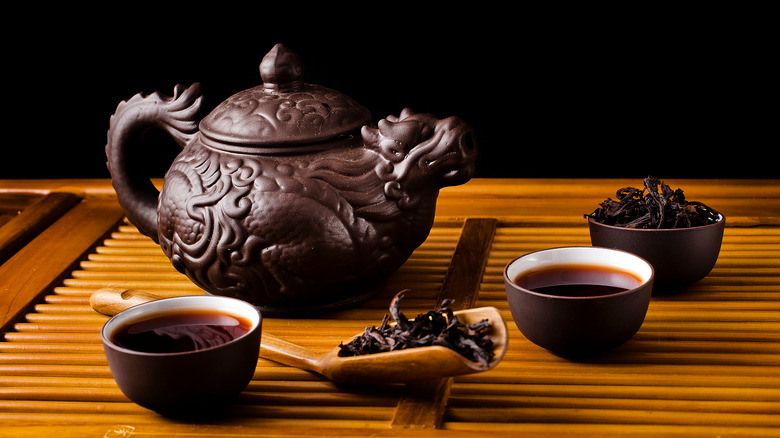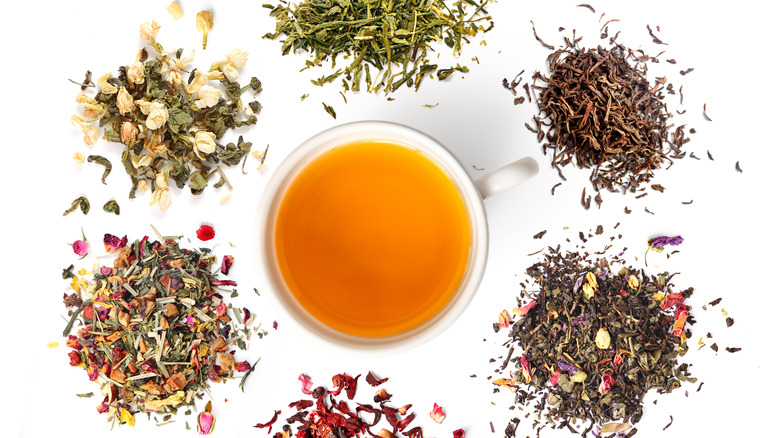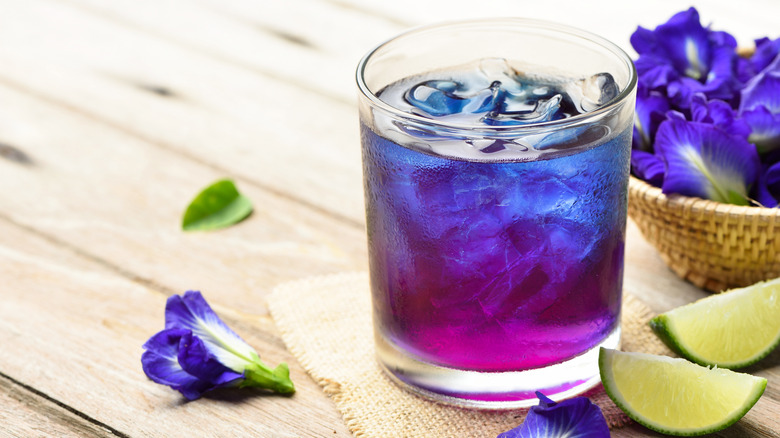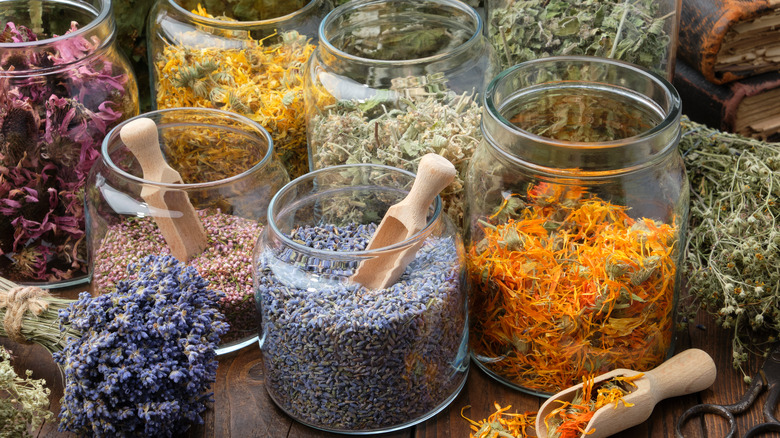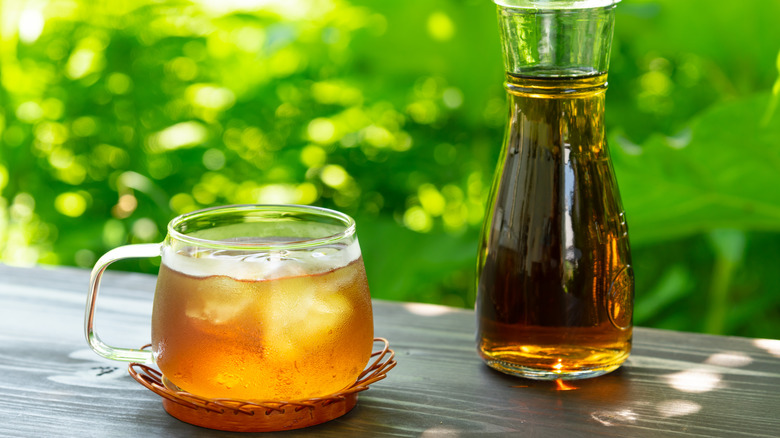What Are The Different Tea Types And How Are They Different
If you absolutely love tea, you've come to the right place. Tea is one of the most soothing, relaxing drinks in the world, synonymous with a slow pour in a mug you sip while cozying up on your couch or armchair — finally getting much needed rest and TLC after constant work meetings and Zoom calls.
A good cup of earl gray tea accompanies your favorite Netflix series, whether you're into the super romantic "Bridgerton" (and the Duke of Hastings) or you prefer mystery thrillers like "The Sinner," "Money Heist," or "You." Cozy chamomile tea might just pair perfectly with the novel you're reading right now about a couple whose marriage is on the rocks, while a zing of refreshing iced green tea is just the thing you need to get your mornings started right before heading off to work or school.
Even if you absolutely adore sweet rose tea or can't live without your classic English Breakfast tea with just a touch of milk and sugar, you might not know all there is to know about the different tea varieties. You might think, it's just all tea, right? Well, the tradition is actually one of the most complex and extensive in the world, and is far more interesting than most people think. As per Artful Tea, while all traditional tea types derive from the camellia sinensis plant, the different categories arise with major differences in harvesting and processing. Curious? Here's everything you need to know about the nine tea types.
Black tea
First up, we have black tea, a variety you are surely familiar with. Black tea encompasses flavors like Darjeeling, English Breakfast Tea, and Earl Gray, according to Revolution Tea, and is the kind of tea you often see out-and-about in brunch places, in many people's kitchen cabinets, and in grocery stores as the "classic" tea type. As explained by Artful Tea, black tea is known for being higher in caffeine than other tea varieties, but still only contains half of coffee's caffeine content. As per Food & Wine, this makes it nice jolt of energy you can sip on throughout the early afternoon without jumping off walls. Black tea doesn't actually show up pitch-black in your mug, but is still a dark, burnt-orange shade, and tastes stronger than other varieties.
So, how does the camellia sinensis, or tea leaf plant, transform into black tea? Different from other varieties (and we'll get to those soon), black tea comes about by allowing the fresh-picked camellia sinensis leaves to oxidize all the way, letting oxygen work its magic. Once the leaves are completely oxidized, they are dried out, crushed, and rolled, making it have a strong "malty" flavor. While this process makes black tea have fewer antioxidants than other types such as green tea, black tea is actually easier to digest for some people because of the oxidation. Moreover, the potent flavor makes it a perfect pairing for milk, cream, honey, and sugar.
Green tea
Next up, we have green tea, otherwise known as black tea's slightly more refreshing, sprightly cousin — and one that you've surely drank before when wanting something light and perfect for midday. Served hot or cold, green tea has a paler, more yellow coloring than black tea, and that's for a very specific reason.
According to Food & Wine, green tea is seen as the opposite of black tea, because while the latter is taken to maximum oxidation for strength of flavor, green tea is all about keeping things light. In fact, when making green tea, harvesters actually attempt to avoid the oxidation process entirely, trying to keep the flavor of the fresh camellia sinensis plant instead. With barely any oxidation, green tea's color isn't just lighter — the flavor is less-bodied and reminds some people of fresh-cut grass or spring air. Plus, while some people find it harder to digest than black tea, according to Artful Tea, the bare-bones approach to processing means all the antioxidants of the tea leaf plant remain intact.
In fact, green tea's antioxidant-rich formulation makes it have countless health benefits, including possible increased brain function, fat burning, and a decreased risk of heart disease down the line (via Healthline). As per the outlet, its antioxidant content might even protect against certain cancers, and is linked to longevity. With popular varieties like Moroccan Mint, green tea is also known to have less caffeine than black tea, so is great for a late afternoon pick-me-up.
Oolong tea
In between rich, robust, dark black tea and the refreshing, light, plant-forward green tea, we have a tea type that falls right in the middle. Oolong tea is only partially oxidized, but the processing techniques can vary as much as each individual shade in the rainbow. As explained by Artful Tea, oolong tea has a supremely varied oxidation range, and can lie anywhere between 10 and 80% oxidized — meaning it vastly depends on who makes it. This means you can pour yourself a dark, robust, malted cup of oolong or a mug that more closely resembles even the mildest of white teas. As per Pique Tea, the roasting and oxidizing time ranges anywhere from eight to 60 hours.
Food & Wine describes the process as similar to cooking up the perfect omelet, with each individual chef or home gourmet connoisseur finding the best techniques and formula that work for them. As per the outlet, withering and roasting oolong tea is a true art, with only a few masters in the world who know how to make the perfect final product.
Because oolong tea is in a different category of its own and varies so greatly depending on technique and even climate, cups of oolong range from pale and yellow-tinged like green tea to darker orange like black teas. There are countless varieties of oolong tea, ranging from Phoenix tea and Wuyi Oolong Tea to the sweeter, milder Milk Oolong Tea that's harvested in the springtime.
White tea
Next up, we have the mildest, most delicate tea variety of them all — even more fine and floaty than green tea, making it the exact opposite of black tea. As you can expect, white tea is decidedly rarer than many other tea types listed, and is viewed as an exquisite delicacy fit for a king or queen — or when you really just want to treat yourself while you watch the "Sex and the City" reboot, "And Just Like That" (with some luxurious honey from your local farmer's market of course!).
As per Thrillist, white tea is the "youngest" of the varieties, and different from green tea, black tea, or oolong. It's not actually made from the camellia sinensis plant, but from its buds. Tea sommelier Mel Hattie explained to the outlet, "white tea is the little baby buds... if you can imagine a fuzzy little pea shoot, that's what a tea plant looks like when it's just starting to be picked." So, how does the process differ from other kinds of tea harvesting? "Only the very first pick of the year can be considered really good quality white tea. You just pluck them between your fingers." Once picked, these buds look like "tiny little butterfly [pods]," making this probably the most adorable tea type in existence. "You pick that, and then process it similar to green tea."
Food & Wine describes the process as "minimal," simply using the sun or air vents, leading to a floral flavor.
Aged or fermented tea
There are also complex varieties of teas that don't fall into the expected categories you might first think of. While many of us have sipped on black tea when just waking up in the morning and several of us have heard of green tea's wellness benefits, one tea type is often left out of the discussion. Fermented tea is rarer to come across, at least in the Western world, but it is an incredible addition to any tea collection.
As described by Food & Wine, some teas are chosen to go through the aging process, sometimes being left to ferment for decades before drinking them. While green teas are not usually left to age, much because their beauty lies in their freshness, several kinds of white, black, and oolong teas only become more interesting and flavorful when left to ferment over time. Just like a wine or cheese, the depth of flavor truly changes over time, and may even undergo "bacterial and fungal activity." Still, as per the outlet, it does not yield alcohol.
Artful Tea points to pu-erh tea, a kind of fermented tea that originated in the city of Pu-erh in China, still being made there today. The outlet explains that only teas fermented in the city can actually be named "pu-erh tea," and those not originating there are simply deemed aged or fermented tea instead. Many people associated fermented tea with black tea, since it is also robust in flavor and highly caffeinated.
Yellow tea
Yellow tea is a tea variety that isn't often discussed, but is absolutely jaw-dropping in its flavor profile. Sure, a cup of earl gray tea and a dash of milk is always welcome, but one sip of yellow tea might make you reconsider your favorite tea flavor. Food & Wine discusses yellow tea as a "fringe tea style," meaning it is not often sipped in most parts of the world, but those who do really love it. The outlet refers to it as "niche" but quite a classic tea variety within China, describing it as similar to green tea with a few key differences.
If you love the refreshing taste of green tea, you'll love yellow tea. Its leaves are further crushed, making the flavor close to white tea in its super-smooth, delicate nature. According to Stash Tea, yellow tea is one of the rarest teas in the entire world, and the way the leaves are processed give it its signature marigold hue. Flavor wise, it is quite light and seen as a midway point between green and white tea in its strength. Good Housekeeping cites Leah Boalt Richardson's deep-dive into yellow tea in her book "Modern Tea: A Fresh Look at an Ancient Beverage," which says this type is "difficult to source because the harvest time is short, the processing is complex and time-consuming, and, until recently, China was the only producer." The process involves pan-firing the tea leaves, and can take a few days to complete.
Purple tea
While yellow tea might have been surprising enough to you, there is another tea you might have never heard of that may just blow your mind. Still extremely uncommon in most parts of the world, purple tea is a new advancement in tea that produces a gorgeous violet hue — and an amazing flavor to boot. Basically reserved for royals, or when you really want to treat yourself (if you can find it), purple tea is one of the most interesting varieties of tea to drink right now.
As described by Artful Tea, purple tea is made from an extremely rare tea plant with purple leaves that's found in India's Assam region. As per the outlet, current production of purple tea is now mostly found in Kenya, and parallels the oolong tea process. After the leaves are picked and harvested, they are oxidized only halfway, leading to a middle-ground flavor that many would describe as mild and sweet, with experts linking it to white tea's flavor (via Stash Tea). The most incredible aspect of purple tea is its color, especially considering it is 100% natural with zero artificial coloring. The result is the most epic shade of maroon, and makes the experience of sipping it even more enjoyable.
When it comes to caffeine, purple tea is on the low side so it can be suitable as an after-lunch or even after-dinner drink. Notably, much like green tea, purple tea is full of antioxidants, making it great for general wellness.
Herbal tea
Now we're moving on to a pretty controversial subject within the tea community, so bear with us! While many of us love to sip on chamomile, lavender, or rose tea, and usually don't give it a second thought in terms of what we're really drinking, some may be surprised to know that these varieties aren't really tea at all. Authentic, true tea is simply derived from the camellia sinensis plant, and if your drink isn't, then it's not truly tea (via Artful Tea). While this might be a difficult truth to swallow (pun intended), infusions have their rightful place in the tea community — they're just seen as distant cousins.
Herbal teas or infusions are made up of botanical blends, combining different plants, herbs, and spices to deliver different benefits to the human body. As per Stash Tea, these blends can even include fruits, flowers, roots, seeds, berries, and barks to bring you maximum healing and relaxation. Caffeine-free, herbal teas include peppermint, hibiscus, dandelion, ginger, and rosehip tea. Each work to make you feel better in a different way, whether relaxing you or even soothing aches and pains.
For one, chamomile infusions are known to help your digestion and regulate sleep patterns, according to Healthline, while peppermint tea is incredible for relieving headaches and even menstrual cramps (via Medical News Today). As explained by Food & Wine, herbal infusions are ancient remedies that have been used as "medicines" for thousands of years and have all kinds of soothing properties.
Grain tea
Yet another rare variety of tea that is practically never given the attention it deserves, and should frankly be given the spotlight much more often? Grain tea. You might be very confused as to what that even is, and if it is a tea in the first place. Well, much like herbal infusions like rose and lavender "teas," grain tea isn't actually tea because it is not derived from the camellia sinensis plant either. Still, it is within the general tea family and is so tasty you might never go back to other teas once you try it (seriously!).
Food & Wine discusses grain tea as a popular drink in Asian countries like Korea and Japan, and are usually made out of grains like barley, buckwheat, and corn silk. The result is extremely unexpected, with a dark, robust coloring that's similar to black tea, and a soft yet rich flavor profile. Much like shaken espressos or cold brews, serving grain tea over ice is a perfect summer staple, and the best part? It has zero caffeine, so you can drink as much as you want all day — even at night before going to sleep. As per Inaka Tea, the most common kind of grain tea is barley tea, with the grains being roasted until darker in color and sweeter in flavor. As explained by Very Well Fit, barley can lead to weight loss, may aid digestion, regulates blood sugar, and may improve dental health and cholesterol.

